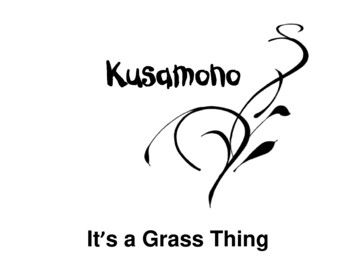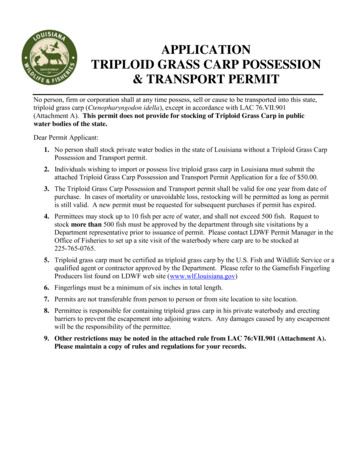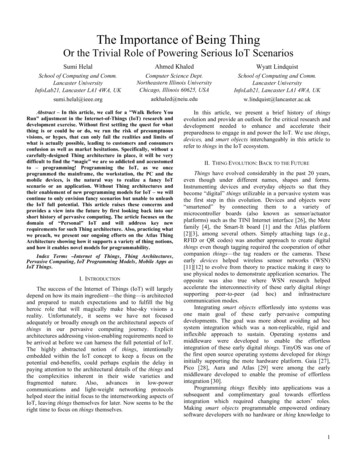
Transcription
It’s a Grass Thing
KusamonoThe term Kusamono appeared around the1870s. They were usually small herbaceousplants collected along with the tree. Theplants were kept in a separate container as acompanion to the tree. These arrangementsbecame gifts for honored guests.The plantings tell us 2 important things: The geographic location of the tree The season the tree was collected
Kusamono arrangements are not temporary butgrow more interesting over time as does thetree they accompany. A mature Kusamono hasno visible soil. It will change with the seasonsas does the tree.The Art of Kusamono has become more popularand prominent over the decades. There areshows that have the Kusamono as the keyfigure without the tree.
Types of Kusamono“Grass Thing”– Kusamono is now the catch term for all GrassPlantings.– It may be a single plant or a variety of a number ofdifferent herbs, grasses, and flowering plants. Shitakusa Kokedama Water Bowl
Shitakuso“Under Grass”Shitakuso is the term for the Kusamono when usedas a companion plant with a tree. This is the typeof planting we are accustomed to seeing.
Owner: Louise Lester
Owner: Louise Lester
Kokedama“Moss Balls”During the Edo era, 1603-1868 in Japan, a popular styleof bonsai evolved as Nearai. The bonsai was grown ina pot until it is totally root bound. It was displayedwithout a pot and displayed on a stand. The rootswere covered with moss. Out of this came the style ofKusamono known as Kokedama.– The Kokedama can have one plant or several with thesame growing conditions. They are often planted with3 heights to represent heaven, man and earth.– There are numerous methods of creating Kokedamaand they are all valid. Finding what works best foryour situation and plants is key.
Water Bowl KusamonoI first ran across this type of Kusamono when Ibought a CD entitled Keiko Yamane Grass andWildflower Plantings. I was disappointed that thecover picture planting that was a water bowl wasnot represented on the CD. It is still a great CDshowing her work.I found a few pictures over the years but I have nothad nor found any instruction.I decided to create my own bowls and havesuccessfully planted many of these.
Kusamono Displays Displaying Kusamono, when used asShitakusa, requires its plants to berepresentative of the Bonsai’s geographiclocation and the season in which it is shown.Shitakusa DisplayThe following picture of display belongs toLouise Lester.
Shitakusa Display If the Shitakusa is in a ceramic pot, it must beplaced on a wooden jita. If the Shitakusa is a Kokedama, or planted onwood, it can be shown on a ceramic jita.
If the Kusamono is displayed as the primaryplant, any type of stand may be used. It is often displayed with a scroll. A secondary smaller planting may accompanythe display or Tenki may be used.– Tenki is the use of figurines such as animals,amphibians, people, etc.– They may be bronze, silver, pewter, ceramic.
InternetLinks & Resources– Kusamono Public Group on Facebook– Searching Kusamono will produce numerous articlesand websites dedicated to the Art of Kusamono– www.kusamonochoe.com Books––––Keshiki Bonsai by Kenji KobayashiPop Bonsai by Lisa TajimaBonsai, Kusamono, Suiseki by Willi BenzFour Seasons of Bonsai by Kyuzo Murata Articles– “Shitakusa versus Kusamono” by Kora Dalager– “The History of Kusamono” by Robert J. Baran
Books –Keshiki Bonsai by Kenji Kobayashi –Pop Bonsai by Lisa Tajima –Bonsai, Kusamono, Suiseki by Willi Benz –Four Seasons of Bonsai by Kyuzo Murata Articles –“Shitakusa versus Kusamono” by Kora Dalager –“The History of Kusamono” by Robert J. Baran. Title: The Art of Kusamono Author: Martha Goff Created Date: 10/14/2019 4:14:29 PM .











